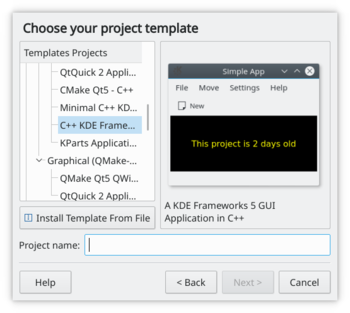KAppTemplate: Difference between revisions
m (be less succint about the purpose of the software at hand) |
(update content) |
||
| Line 19: | Line 19: | ||
<!--T:8--> | <!--T:8--> | ||
* Templates especially for KDE-development (plugins for Plasma, | * Templates especially for KDE-development (plugins for Plasma, [[Special:myLanguage/KRunner|KRunner]], [[Special:myLanguage/KDevelop|KDevelop]] plugins, [[Special:myLanguage/Akonadi|Akonadi]], [[Special:myLanguage/Kate|KTextEditor]] plugins, ...) | ||
<!--T:9--> | <!--T:9--> | ||
| Line 26: | Line 26: | ||
<!--T:10--> | <!--T:10--> | ||
* Integrated into KDevelop | * Integrated into KDevelop | ||
== More Information == | |||
<!--T:4--> | <!--T:4--> | ||
The Handbook is available from [http://docs.kde.org/development/en/kdesdk/kapptemplate/index.html here] | * The Handbook is available from [http://docs.kde.org/development/en/kdesdk/kapptemplate/index.html here]. | ||
<!--T:5--> | <!--T:5--> | ||
[[Category:Development]] | [[Category:Development]] | ||
</translate> | </translate> | ||
Revision as of 21:22, 25 January 2019
Features
- Templates for C++, Ruby, Python and PHP
- Categories
- Templates for different build-systems and frameworks
- Templates especially for KDE-development (plugins for Plasma, KRunner, KDevelop plugins, Akonadi, KTextEditor plugins, ...)
- It is easy to create new templates using space holders and a simple CMake-command
- Integrated into KDevelop
More Information
- The Handbook is available from here.

